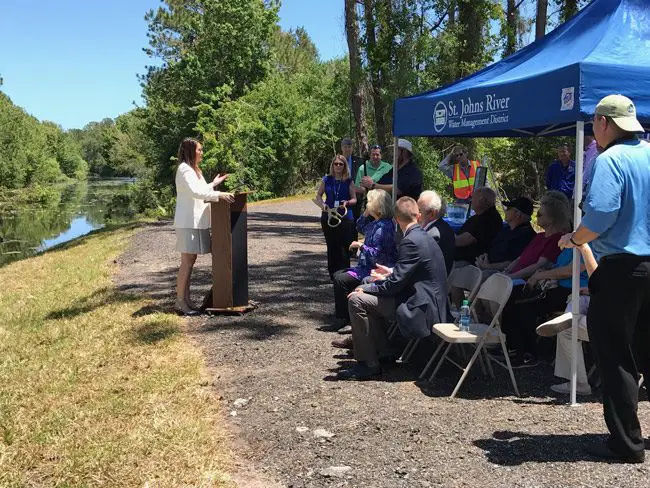
What the hell is a weir?
Don’t feel bad for not knowing: it’s not really an American word (it’s not really a word at all), and its better days, when it had any–usually along English rivers–are long past.
The Oxford English Dictionary defines a weir as “A barrier or dam to restrain water, esp. one placed across a river or canal in order to raise or divert the water for driving a mill-wheel.” It is also a dam of various forms, “constructed on the reaches of a canal or navigable river, to retain the water and regulate its flow.” It’s had all sorts of spellings–were, weare, weires, wears, weer, and of course weir, the current preference among the six and a half people who speak the word in any given year on the planet (five of them in Palm Coast).
There’s an obscure reference to a “wer” in old English at the end of the 9th century, many more recognizable references to “a Damme or Were” and to “Wears” or “weer” on London’s Thames River in the 17th, as when Defoe of Crusoe fame referred to one in his “Journal of the Plague Year” in 1722 (he spelled it more charmingly as weer). And there’s this from an 1875 history of the Thames, whose author–H.R. Robertson–felt it necessary to provide some phonetic advice along the sail: “A boat descending the stream meets with no impediment till it reaches the dam or ‘weir’ (pronounced ‘wire’ by the riverside people), as it is technically called.” Riverside people now just bully you toward the London Eye and pronounce it aye.
H.L. Mencken was right when he noted in his “American Language” that the word weir was “almost unknown in the United States,” or anywhere for that matter beyond the affected language of boaters on the Thames. Even in England it had been a colloquialism rather than an honest-to-god word worthy of attention, let alone celebration. That it shares 80 percent of weird‘s DNA is no coincidence.
Until you get to Palm Coast, where the word appears to be enjoying its most gushing renaissance since “The Plague Years.”
“This is one of our most unusual ribbon-cuttings we’ve ever done,” Palm Coast Mayor Milissa Holland said today, standing by the gurgling waters of a B-Section canal once as obscure as the 9th century spelling of the Word of the Day. “It’s to celebrate the reconstruction of the BS-2 water control structure, better known as a weir.” The acronym in the sentence does not, of course, refer to its usual meaning, tempting as the context makes it (the mayor, to her immense credit, pronounced BS-2 as river people might not: with a straight face). It refers rather to the eminently poetic “B Section.” The weir is off of Barrington Drive in Palm Coast, on the so-called Barrister Waterway, a structure almost as old as the word, in Palm Coast years: it was built during the Carter era by ITT, the original developer of the city, doubling as a bridge to the northern part of Palm Coast before th city truly discovered asphalt. But it did little to alleviate flooding in the area, according to a city release. The reconstruction is intended to help in that regard.

And this should be said of the 31 weirs in Palm Coast: they do play a significant role in flood control in a city crisscrossed by canals in parts, and dependent on an effective drainage system to stay relatively dry. “They’re all located on our freshwater canals,” Holland said, reading from prepared remarks. “We have 54 miles of freshwater canals in our city. They’re all part of our stormwater drainage system, made up of swales, ditches and canals. The weirs allow us to control the stormwater runoff to prevent flooding, and the system has proven to be very effective within our community over the years. It’s also environmentally friendly.” (See the full design of the weir replacement here.)
Technically, the St. Johns River Water Management District funded the $334,000 reconstruction project.
“I’m very proud of the efforts here in Palm Coast,” St. Johns River Water Management District Executive Director Ann Shortelle said. “Over the last few years, this partnership with the district and the city has resulted in nine completed or ongoing projects. We have provided $4.2 million for these projects, and I think I was informed that on our new cost-share, we’ve got a few more applications that have been submitted, which is truly awesome.”
Shortelle was stretching the definition of “we” when she referred to the management district as entirely responsible for paying for the projects. The district merely redistributed Palm Coast’s money and called the project its own. Palm Coast residents contribute in taxes three times as much to the water management district as they do to their own Environmentally Sensitive Lands program (even though they voted to enact the latter, but have no representation on the management district board, nor is that board elected, nor do Palm Coast residents have a voice in deciding the property tax rate the management district levies on them, yet the management district makes it appear as if it were doing the city a favor by returning some of its money). A Palm Coast property owner with a $175,000 house pays $36 a year in taxes to the water management district. The city gets back only a fraction of what it pays in. Weir.
Two other city council members–Nick Klufas and Bob Cuff–then joined Holland and City Manager Jim Landon to cut the ribbon, with Jon Netts, the former mayor, standing nearby and asking afterward: “Show me how it works.” If Carly Simon were there, she’d have sung Let The River Run (We’re coming to the edge/running on the water/coming through the weir…”), trembling and shaking like the frothy waters below.
![]()





























Leave a Reply